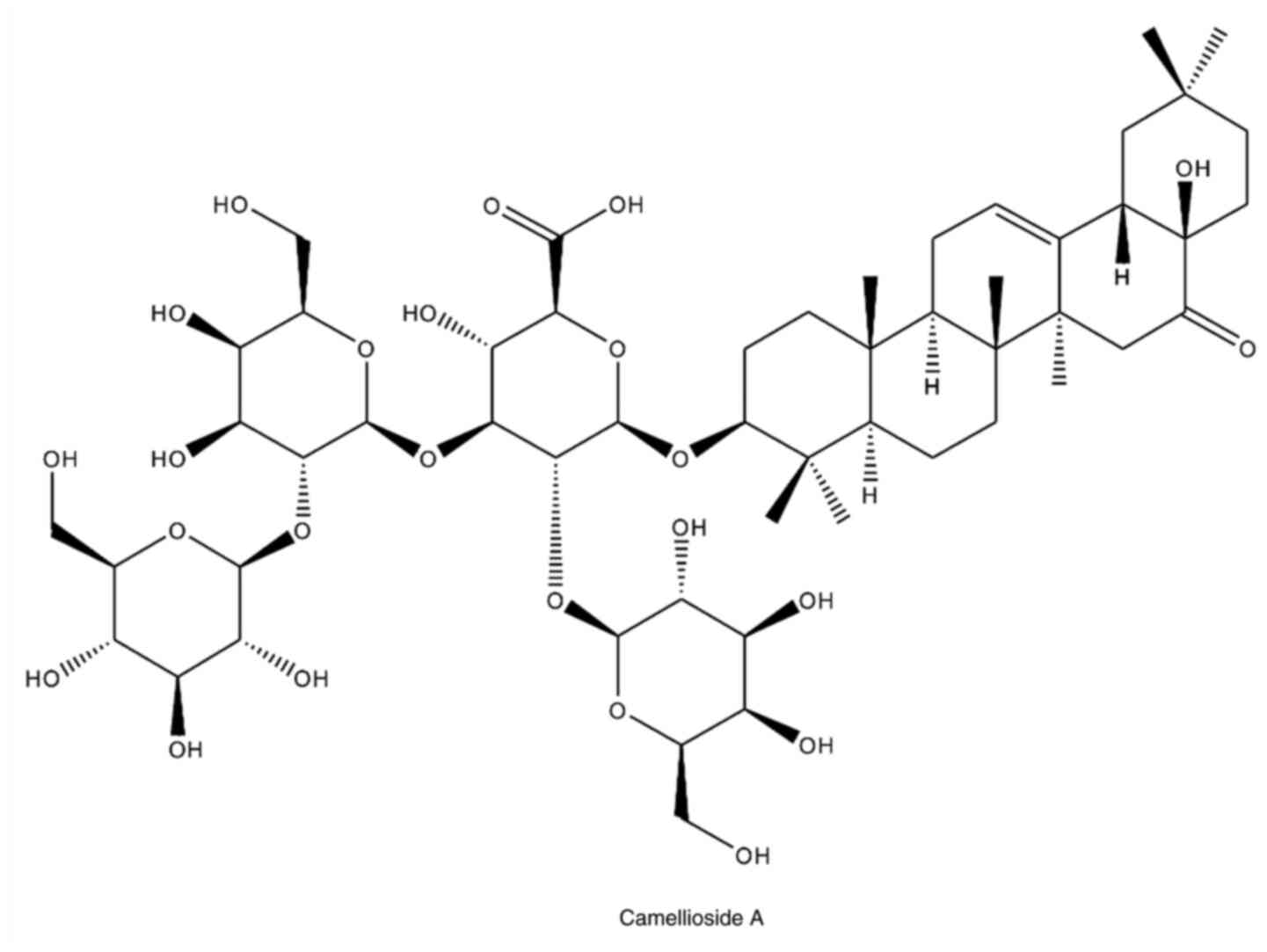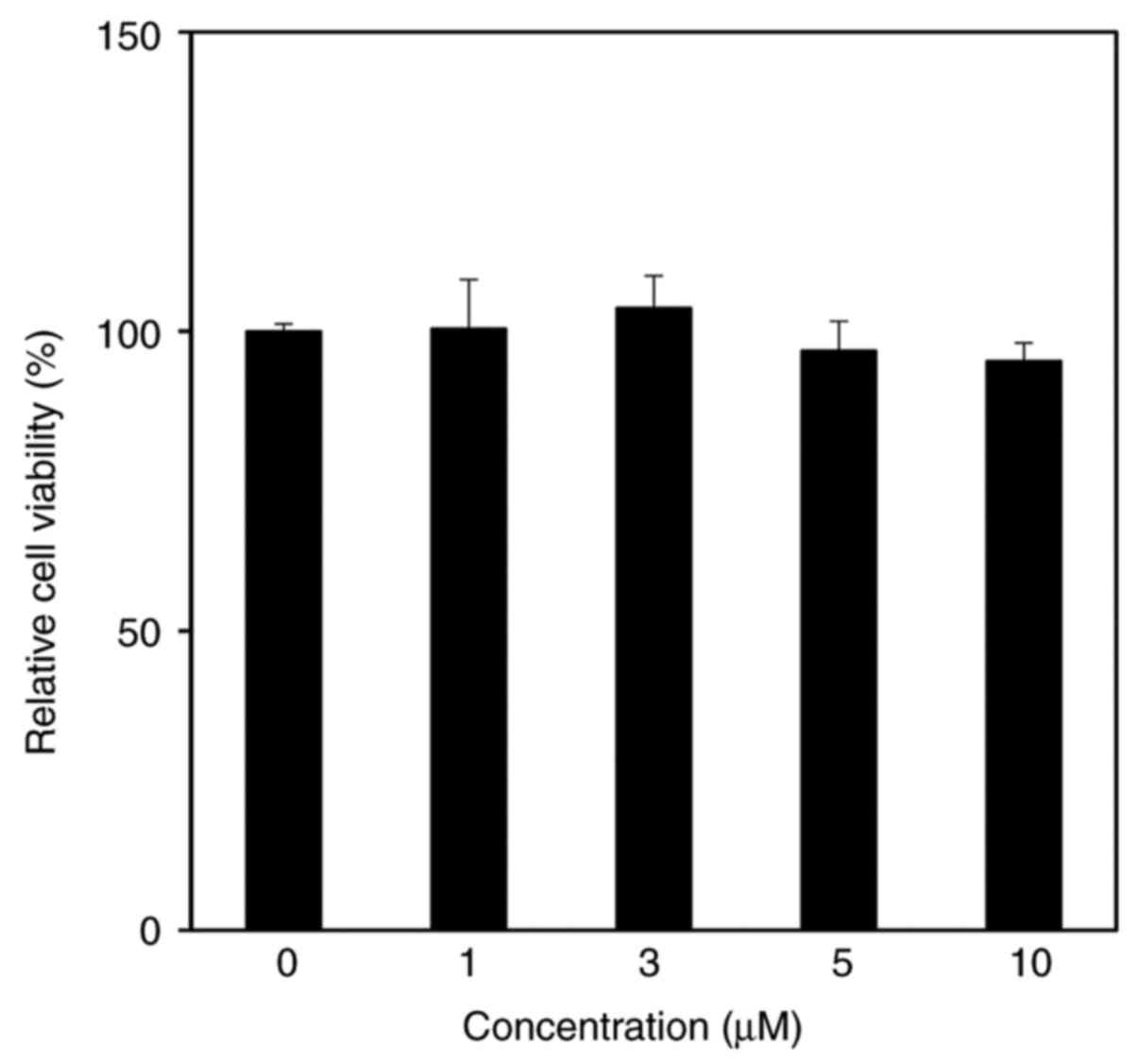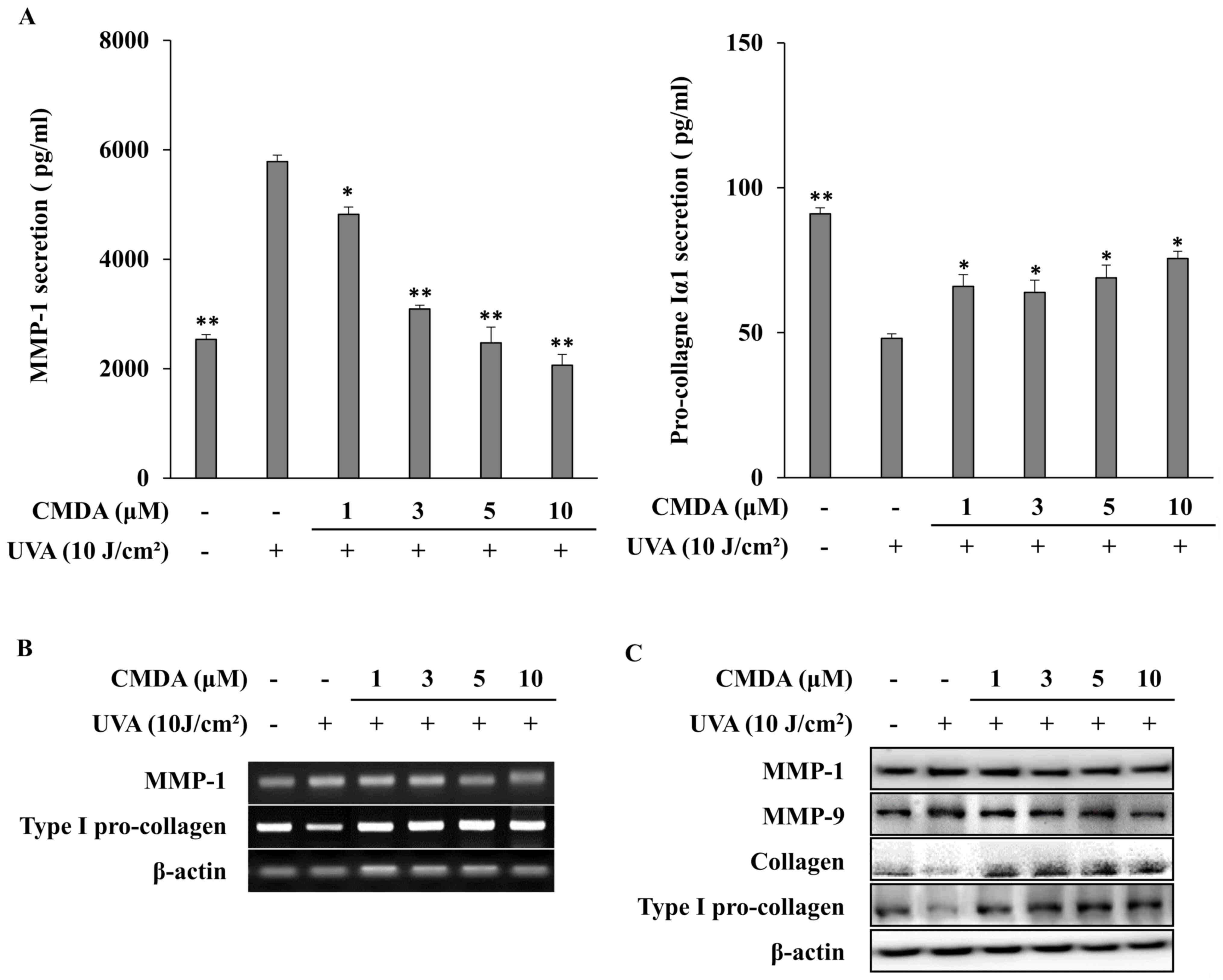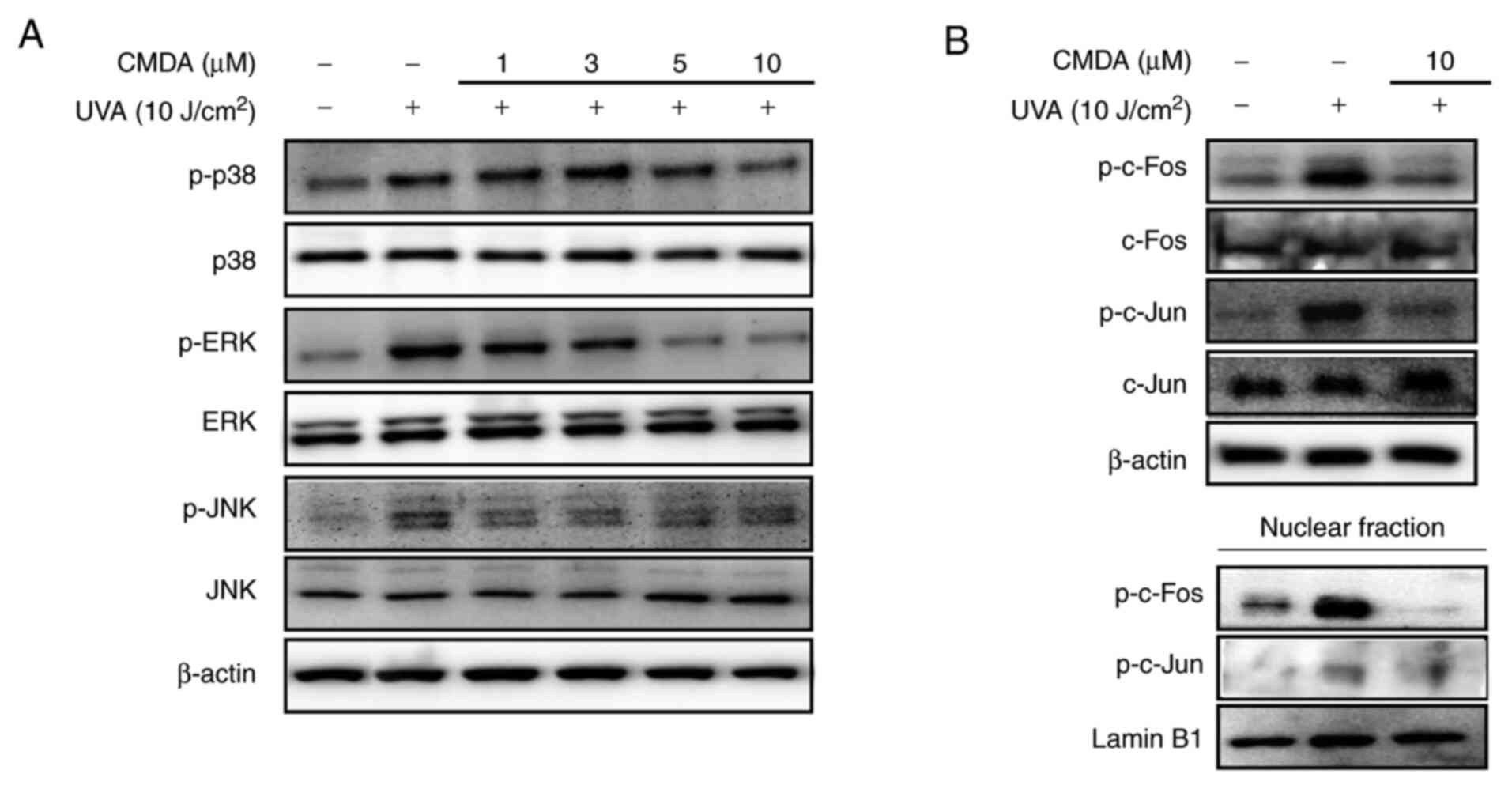Camellioside A, isolated from Camellia japonica flowers, attenuates UVA‑induced production of MMP‑1 in HaCaT keratinocytes via suppression of MAPK activation
- Authors:
- Published online on: November 5, 2020 https://doi.org/10.3892/etm.2020.9448
- Article Number: 16
Abstract
Introduction
The skin serves as a barrier against extrinsic factors and is continuously in contact with potentially harmful elements, such as toxic substances, microbial organisms and solar radiation. Exposure to ultraviolet (UV) radiation has detrimental effects, which may manifest as sunburn, inflammation, tumorigenesis and aging (1). The latter is also referred to as photoaging and is characterized by connective tissue degradation. Solar UV radiation, the primary cause of extrinsic skin aging, is divided into three subgroups according to wavelength: UVA, 320-400 nm; UVB, 280-320 nm; and UVC, 200-280 nm. Of the two UV subgroups that can reach the human skin, UVA is responsible for ~95% of total radiation exposure compared with UVB (2). UVA-exposed skin begins to exhibit photoaging symptoms, including loss of elasticity and strength, inflammation and wrinkle formation. In addition to the DNA damage, the damage caused by UV irradiation is primarily due to rapid degradation of the extracellular matrix (ECM), which is the result of an increase in the production of ECM-degrading enzymes, namely matrix metalloproteinases (MMPs) (3). Among different types of MMPs that are expressed in various parts of the body, collagenase MMP-1 and gelatinase MMP-9 are predominantly found in skin cells. Degradation of the main components of the ECM is primarily carried out by MMP-1 and MMP-9. UVA irradiation induces the expression and activation of MMP-1 and MMP-9 in keratinocytes, subsequently increasing collagen degradation and decreasing collagen production (4). Therefore, ameliorating UVA-induced alterations in MMP expression and collagen production may serve to prevent photoaging. Medicinal plants are widely recognized for their various secondary metabolites with beneficial health effects. Apart from their medicinal uses for the treatment of diseases and complications, certain plants, such as Rosmarinus officinalis, Thymus vulgaris and Smallanthus sonchifolius, exert skin-protective effects, including inhibition of UV-mediated MMP-1 activity (5). Similar MMP-1 inhibitory effects were reported for natural plants of Asian origin, such as Typha orientalis Nymphaea tetragona and Filipendula glaberrima (6). Camellia japonica (C. japonica) is a plant native to Asia that is widely cultivated worldwide as a garden plant. Therefore, cultivars of C. japonica are widely available and its flowers may be easily found. Over the past decades, C. japonica has attracted attention as a cosmeceutical ingredient due to its beneficial moisturizing, antimicrobial, anti-inflammatory and antioxidant properties (7). Therefore, the aim of the present study was to investigate the effect of Camellioside A (CMDA), a triterpenoid saponin from C. japonica, against UVA-induced photoaging in HaCaT human keratinocytes with respect to MMP-1 expression and collagen production and degradation.
Materials and methods
Isolation and characterization of CMDA
C. japonica flowers were hand-collected in Namwon-eup (Jeju island, Republic of Korea) in January 2018. Samples were identified by Dr Gwanpil Song (Jeju Biological Resource Co.), and a voucher specimen (no. AP-0104) was deposited at the Plant Archive of Amorepacific Research and Development Center for future reference. The collected flowers were sun-dried and ground into a fine powder using an electric mill. Powdered samples were stored in a sealed container at 4˚C until further use.
Dried C. japonica flowers (200 g) were extracted three times with 80% ethanol (1 l) over 3 days. Evaporation of the solvent under vacuum gave the crude extract (98 g). The crude extract was partitioned between ethyl acetate (2 l) and H2O (1 l) mixture to give an ethyl acetate soluble fraction (4.5 g) and aqueous phase, which was extracted with 1-butanol (1lx2) to give 1-butanol fraction (31 g). A part of the 1-butanol fraction (5.6 g) was subjected to reverse-phase silica gel column to give eight fractions. Fractions 6, 7 and 8 contained crude compound 1 (587 mg). Crude compound 1 fractions were purified by preparative high-performance liquid chromatography (HPLC; MeCN-H2O =35:65, v/v; both solvents were acidificed by 0.1% TFA, flow rate =15 ml/min, column temperature =30˚C) to give pure compound 1 (243 mg). A Gilson HPLC system (Gilson, Inc.) was used for preparative HPLC possessing a UV/Vis-155 detector, binary pumps, and a GX-271 liquid handler. The HPLC column for preparative HPLC was a Luna C18(2) column (21.2x250 mm I.D., 5 µm; Phenomenex). Compound 1 isolated from the flower of C. japonica was identified as Camellioside A (CMDA) by nuclear magnetic resonance spectroscopy (NMR) and mass spectroscopic analyses (Fig. 1). The spectroscopic data of CMDA matched published values (7).
HaCaT human keratinocyte culture and maintenance
HaCaT cells (cat. no. 300493; CLS Cell Line Service GmbH) were cultured in 6-well plates with DMEM (Sigma-Aldrich; Merck KGaA) supplemented with 10% FBS (Sigma-Aldrich; Merck KGaA) at 37˚C with 5% CO2.
Cell viability assay
The viability of HaCaT keratinocytes was analyzed by conducting a colorimetric MTT assay. HaCaT cells (1x104 cells/well) were cultured in 96-well plates and incubated for 24 h at 37˚C prior to treatment with different concentrations (1, 5 and 10 µM) of CMDA that were introduced in serum-free fresh medium. After incubation for 24 h at 37˚C, the supernatant was removed and 100 µl MTT [1 mg/ml (m/v)] in PBS was added to the cells. Following incubation for 4 h at 37˚C, 50 µl DMSO was added to each well to stop the reaction and solubilize the formazan crystals. The optical density of each well was measured at a wavelength of 540 nm using a GENios® microplate reader (Tecan Group, Ltd.). Cell viability was plotted as a relative percentage against the untreated control group.
UVA irradiation
UVA irradiation was performed using a Bio-Sun UV Irradiation System (Vilber Lourmat) fitted with a UVA source designed for microplates. HaCaT cells grown in 6-well plates (1.5x106 cells/well) were placed in the UVA irradiation system and exposed to UVA (10 J/cm2). Cells were irradiated in PBS without the plastic lid. When the irradiation matched the desired programmed energy (10 J/cm2), the UVA irradiation automatically stopped, and the cells were then incubated in previously mentioned culture medium, with or without CMDA treatment, until analysis.
MMP-1 and pro-collagen Iα1 ELISA
The production of MMP-1 and type Iα1 pro-collagen was investigated by performing ELISA. HaCaT keratinocytes were pre-incubated in 6-well plates (1.5x106 cells/well) for 24 h at 37˚C and washed with PBS before UVA (10 J/cm2) exposure. After UVA irradiation, the cells were treated with or without different concentrations of CMDA for 24 h at 37˚C. The contents of MMP-1 and type Iα1 pro-collagen in the cell culture media was assessed using an ELISA kit (Human Total MMP-1 DuoSet ELISA, cat no. DY901B; Human Pro-Collagen I alpha 1 DuoSet ELISA, cat. no. DY6220; both from R&D Systems, Inc.) according to the manufacturer's protocol.
Reverse transcription-semi-quantitative PCR analysis
HaCaT keratinocytes were grown to confluence in 6-well plates (1.5x106 cells/well) and the control group was subjected to UVA irradiation (10 J/cm2) only. Following UVA irradiation, cells were treated with CMDA for 24 h at 37˚C. Total RNA was extracted from HaCaT keratinocytes using TRIzol® reagent (Invitrogen; Thermo Fisher Scientific, Inc.). Total RNA (2 µg) was reverse-transcribed into cDNA using CellScript All-in-One cDNA synthesis Master Mix (CellSafe Co., Ltd.) following manufacturer's protocol with T100 thermal cycler (Bio-Rad Laboratories, Inc.). The following temperature protocol was used for reverse transcription: 42˚C for 60 min and 72˚C for 5 min. Subsequently, qPCR was performed using the following primers: MMP-1 forward, 5'-GGAGCCAGCTCCCTCTATTT-3' and reverse, 5'-GGCTACATGGGAACAGCCTA-3'; type I pro-collagen forward, 5'-AGAAGGAAATGGCTGCAGAA-3' and reverse, 5'-GCTCGGCTTCCAGTATTGAG-3'; and β-actin forward, 5'-CCACAGCTGAGAGGGAAATC-3' and reverse, 5'-AAGGAAGGCTGGAAAAGAGC-3'. Amplification of cDNA was performed using the Thermal Cycler Dice Real-Time System TP800 (Takara Bio, Inc.) using Luna® Universal qPCR Mix (New England Biolabs, Inc.) according to manufacturer's protocol. The following thermocycling conditions were used for qPCR: 30 cycles at 95˚C for 45 sec, 60˚C for 1 min and 72˚C for 45 sec. The final PCR products were separated by electrophoresis for 30 min at 100 V on a 1.5% agarose gel. Following staining with 1 mg/ml ethidium bromide, gels were imaged under a UV light using a CAS-400SM Davinch-Chemi Imager™ (Davinch-K).
Western blotting
HaCaT cells (1.5x106 cells/well) cultured in 6-well plates were treated with or without CMDA for 24 h at 37˚C after UVA (10 J/cm2) irradiation. Protein levels in cells were investigated using standard western blotting techniques. Briefly, cell lysates were prepared by vigorous pipetting of each well with 1 ml RIPA buffer (Sigma-Aldrich; Merck KGaA) at 4˚C. The nuclear fraction extraction was carried out using a NE-PERTM Nuclear Extraction kit (cat. no. 78835; Thermo Fisher Scientific, Inc.) according to the manufacturer's instructions. Total protein was quantified using a bicinchoninic acid protein assay (Thermo Fisher Scientific, Inc.) according to the manufacturer's protocol. Proteins (20 µg) were separated via 12% SDS-PAGE at 100 V and transferred onto PVDF membranes (Amersham; Cytiva) using a wet system run at 100 V for 1 h at 4˚C. The membranes were then incubated for 1 h at room temperature in 5% skimmed milk for blocking. Following blocking, the membranes were washed with 1X TBST (0.1% Tween-20) and incubated with primary antibodies [1:1,000 in primary antibody dilution buffer containing 1X TBST with 5% bovine serum albumin (Sigma-Aldrich; Merck KGaA)] overnight at 4˚C. The following primary antibodies were used: MMP-1 (cat. no. sc-6837; Santa Cruz Biotechnology, Inc.), MMP-9 (cat. no. 393857; Cell Signaling Technology, Inc.), type I pro-collagen (cat. no. sc-8782; Santa Cruz Biotechnology, Inc.), p38 (cat. no. 8690; Cell Signaling Technology, Inc.), phosphorylated (p)-p38 (cat. no. 4511; Cell Signaling Technology, Inc.), JNK (cat. no. LF-PA0047; Thermo Fisher Scientific, Inc.), p-JNK (cat. no. sc-293136; Santa Cruz Biotechnology, Inc.), ERK (cat. no. 4695; Cell Signaling Technology, Inc.), p-ERK (cat. no. 4370; Cell Signaling Technology, Inc.), c-Jun (cat. no. sc-74543; Santa Cruz Biotechnology, Inc.), p-c-Jun (cat. no. sc-822; Santa Cruz Biotechnology, Inc.), c-Fos (cat. no. sc-7202; Santa Cruz Biotechnology, Inc.), p-c-Fos (cat. no. 5348s; Cell Signaling Technology, Inc.), β-actin (cat. no. sc-47778; Santa Cruz Biotechnology, Inc.) and lamin B1 (cat. no. sc-374015; Santa Cruz Biotechnology, Inc.). Subsequently, the membranes were incubated with horseradish peroxidase-conjugated secondary antibodies (1:1,000) for 1 h at room temperature. The following source specific secondary antibodies were used: anti-mouse (cat. no. 7076; Cell Signaling Technology, Inc.), anti-rabbit (cat. no. 7074; Cell Signaling Technology, Inc.) and anti-goat (cat. no. sc-2354; Santa Cruz Biotechnology, Inc.). Protein bands were visualized using an ECL Western blot detection kit (Amersham; Cytiva). Protein bands were imaged with CAS-400SM Davinch-Chemi imager™ (Davinch-K).
Statistical analysis
All experiments were performed in triplicate. Data are presented as the mean ± standard deviation. Comparisons among multiple groups were analyzed using one-way ANOVA followed by Tukey's post hoc test. Statistical analyses were conducted using SAS software (version 9.1; SAS Institute, Inc.).
Results
CMDA inhibits UVA-induced expression of MMP-1 and collagen
The cytotoxicity of CMDA in HaCaT keratinocytes was assessed by performing an MTT assay. The results suggested that CMDA treatment up to 10 µM did not exert any toxic effects on HaCaT keratinocytes (Fig. 2). Subsequently, to verify the effect of CMDA on UVA-induced changes in MMP-1 and collagen production, cellular MMP-1 and pro-collagen Iα1 release were investigated using ELISA. Exposure to UVA (10 J/cm2) increased MMP-1 release to 5,782.7 pg/ml from 2,536.3 pg/ml (non-irradiated control), whereas pro-collagen Iα1 release was decreased to 48.1 pg/ml from 91.0 pg/ml (Fig. 3A). CMDA treatment of HaCaT keratinocytes following UVA-irradiation dose-dependently inhibited MMP-1 release. At 10 µM, CMDA-treated keratinocyte culture medium contained 2,063.0 pg/ml MMP-1, which was a 64.3% decrease compared with the UVA treatment-only group. Parallel effects were observed for pro-collagen Iα1 release; however, dose dependency was not observed, as 1, 3 and 5 µM CMDA increased pro-collagen Iα1 levels to 65.9, 63.9 and 68.9 pg/ml, respectively, whereas keratinocytes treated with 10 µM CMDA produced 75.6 pg/ml pro-collagen Iα1, which was a 57.2% increase compared with the UVA treatment-only group.
The results obtained from mRNA and protein expression analyses were in agreement with the ELISA results. CMDA treatment dose-dependently inhibited the mRNA (Fig. 3B) and protein (Fig. 3C) expression of MMP-1 in UVA-irradiated HaCaT keratinocytes. Type I pro-collagen mRNA expression was also upregulated following CMDA treatment. The protein levels of collagen and type I pro-collagen were similarly stimulated by CMDA treatment, which indicated that CMDA-treated keratinocytes exhibited an increase in their ability to produce collagen, which was inhibited by UVA irradiation. In addition, CMDA treatment also suppressed UVA-induced MMP-9 levels in keratinocytes.
CMDA suppresses UVA-stimulated activation of the mitogen-activated protein kinase (MAPK)/activator protein 1 (AP-1) signaling pathway
MAPK/AP-1 signaling regulation was investigated in order to determine the mechanism underlying CMDA-mediated MMP-1 suppression. UV irradiation stimulates the activation of p38, ERK and JNK MAPKs, leading to the phosphorylation of the c-Fos and c-Jun proteins. The cascade facilitates the formation of AP-1 transcription factor and its nuclear translocation (6). Keratinocytes irradiated by UVA displayed increased levels of phosphorylated p38, ERK and JNK MAPKs (Fig. 4A). Treatment with CMDA (1, 3, 5 and 10 µM) dose-dependently suppressed UVA-induced phosphorylation of MAPKs, whereas the total protein levels of MAPKs were not altered. Subsequently, the phosphorylation levels of MAPK downstream proteins for MMP-1 transcriptional expression (c-Fos and c-Jun) were investigated. UVA irradiation significantly increased phosphorylated c-Fos and c-Jun levels in total cell lysates and nuclear fractions (Fig. 4B), which was parallel to an increase in MAPK activation. The UVA-stimulated increase of AP-1-forming proteins was notably suppressed following treatment with 10 µM CMDA. These results suggested that CMDA suppresses UVA-mediated MMP-1 production via suppression of AP-1 regulated transcriptional activity.
Discussion
C. japonica is a flowering plant endemic to East Asia with known cosmeceutical benefits. It was previously demonstrated that C. japonica oil promotes skin barrier function and type I pro-collagen production (8). Based on these properties, several bioactive compounds have been isolated from C. japonica, and their bioactivities have been reported (7,9). CMDA is one such compound, an oleanane triterpenoid saponin. In addition to the MMP-1 inhibitory and pro-collagen production stimulatory effects of C. japonica oil (9), the present study was conducted to investigate the possible effects of CMDA against UVA-induced skin aging using MMP-1 and type I pro-collagen production as markers.
UV irradiation disrupts the collagen formation of ECM, which is one of the leading causes of extrinsic skin aging, also referred to as photoaging (2). It was previously demonstrated that solar UVA radiation caused elevated MMP-1 production along with diminished collagen production, which in turn resulted in excessive degradation of skin collagen. Increased degradation of the collagen framework of the skin results in skin abnormalities, such as wrinkles (4). In the present study, HaCaT keratinocytes released increased amounts of MMP-1 and significantly decreased amounts of type Iα1 pro-collagen following UVA irradiation, whereas CMDA treatment attenuated MMP-1 release and increased type Iα1 pro-collagen release. The results suggested that CMDA may serve a role in reversing UVA-induced damage of the skin ECM.
Expression of the MMP-1 gene is transcriptionally regulated by the AP-1 transcription factor, which is a heterodimerized form of phosphorylated c-Fos and c-Jun proteins (10). UVA irradiation contributes to MMP-1 expression via activation of MAPK signaling pathways, which are responsible for c-Fos and c-Jun heterodimerization and subsequent nuclear translocation. Translocation of AP-1 initiates MMP-1 expression (8). The results of the present study further indicated that UVA irradiation caused increased phosphorylation of the p38, ERK and JNK MAPKs, which were responsible for the phosphorylation of the c-Fos and c-Jun proteins. In addition, the nuclear fractions of UVA-irradiated HaCaT keratinocytes exhibited significantly higher levels of phosphorylated c-Fos and c-Jun compared with the non-irradiated control group. The presence of CMDA in the culture medium after UVA irradiation exerted suppressive effects on the activation of MAPK signaling, resulting in decreased levels of phosphorylated p38, MAPK and ERK. This effect of CMDA was also observed in both total cell lysate and nuclear fraction levels of phosphorylated c-Fos and c-Jun. Overall, the results of the present study indicated that CMDA suppressed AP-1 transcription factor formation, thereby inhibiting UVA-induced MMP-1 production.
In conclusion, the present study suggested that CMDA may serve as a potential anti-photoaging agent by exerting protective effects against UVA-induced collagen degradation in keratinocytes. The results also indicated that CMDA exerted its effects via suppression of AP-1-regulated MMP-1 expression. Therefore, CMDA and its source, C. japonica extract, may be useful in the cosmeceutical industry for the development of products that protect against skin aging. However, further studies are required to elucidate the underlying mechanism and to verify the results of the present study in vivo.
Acknowledgements
Not applicable.
Funding
The present study was performed within the program of the AMOREPACIFIC Open Research (grant no. SRT-01-R19E80012) supported by a grant from AMOREPACIFIC.
Availability of data and materials
The datasets used and/or analyzed during the present study are available from the corresponding author on reasonable request.
Authors' contributions
FK, JHO and CSK conceived the study, designed the experiments and supplied the necessary materials. FK, JHO and HRK performed the experiments and collected the data. JK conducted the isolation and chemical elucidation analysis. FK interpreted and analyzed the data. All authors have read and approved the final manuscript.
Ethics approval and consent to participate
Not applicable.
Patient consent for publication
Not applicable.
Competing interests
The authors declare that they have no competing interests.
References
|
Dupont E, Gomez J and Bilodeau D: Beyond UV radiation: A skin under challenge. Int J Cosmet Sci. 35:224–232. 2013.PubMed/NCBI View Article : Google Scholar | |
|
Widel M, Krzywon A, Gajda K, Skonieczna M and Rzeszowska-Wolny J: Induction of bystander effects by UVA, UVB, and UVC radiation in human fibroblasts and the implication of reactive oxygen species. Free Radic Biol Med. 68:278–287. 2014.PubMed/NCBI View Article : Google Scholar | |
|
Battie C, Jitsukawa S, Bernerd F, Del Bino S, Marionnet C and Verschoore M: New insights in photoaging, UVA induced damage and skin types. Exp Dermatol. 23 (Suppl 1):S7–S12. 2014.PubMed/NCBI View Article : Google Scholar | |
|
Dong KK, Damaghi N, Picart SD, Markova NG, Obayashi K, Okano Y, Masaki H, Grether-Beck S, Krutmann J, Smiles KA and Yarosh DB: UV-induced DNA damage initiates release of MMP-1 in human skin. Exp Dermatol. 17:1037–1044. 2008.PubMed/NCBI View Article : Google Scholar | |
|
Duque L, Bravo K and Osorio E: A holistic anti-aging approach applied in selected cultivated medicinal plants: A view of photoprotection of the skin by different mechanisms. Ind Crops Prod. 97:431–439. 2017. | |
|
Kim YH, Kim KS, Han CS, Yang HC, Park SH, Ko KI, Lee SH, Kim KH, Lee NH, Kim JM and Son KH: Inhibitory effects of natural plants of Jeju Island on elastase and MMP-1 expression. Int J Cosmetic Sci. 29:487–488. 2007.PubMed/NCBI | |
|
Nakamura S, Moriura T, Park S, Fujimoto K, Matsumoto T, Ohta T, Matsuda H and Yoshikawa M: Melanogenesis inhibitory and fibroblast proliferation accelerating effects of noroleanane- and oleanane-type triterpene oligoglycosides from the flower buds of Camellia japonica. J Nat Prod. 75:1425–1430. 2012.PubMed/NCBI View Article : Google Scholar | |
|
Panich U, Chaiprasongsuk A, Lohakul J, Soontrapa K and Sampattavanich S: Photoprotective role of Nrf2 in UVA-mediated MMP-1 via MAPK/AP-1 signaling in keratinocyte HaCaT cells and mouse skin: The photoprotective effects of sulforaphane. Free Radic Biol Med. 100(S44)2016. | |
|
Kim M, Son D, Shin S, Park D, Byun S and Jung E: Protective effects of Camellia japonica flower extract against urban air pollutants. BMC Complement Altern Med. 19(30)2019.PubMed/NCBI View Article : Google Scholar | |
|
Wang X and Bi Z: UVB-irradiated human keratinocytes and interleukin-1alpha indirectly increase MAP kinase/AP-1 activation and MMP-1 production in UVA-irradiated dermal fibroblasts. Chin Med J (Engl). 119:827–831. 2006.PubMed/NCBI |













